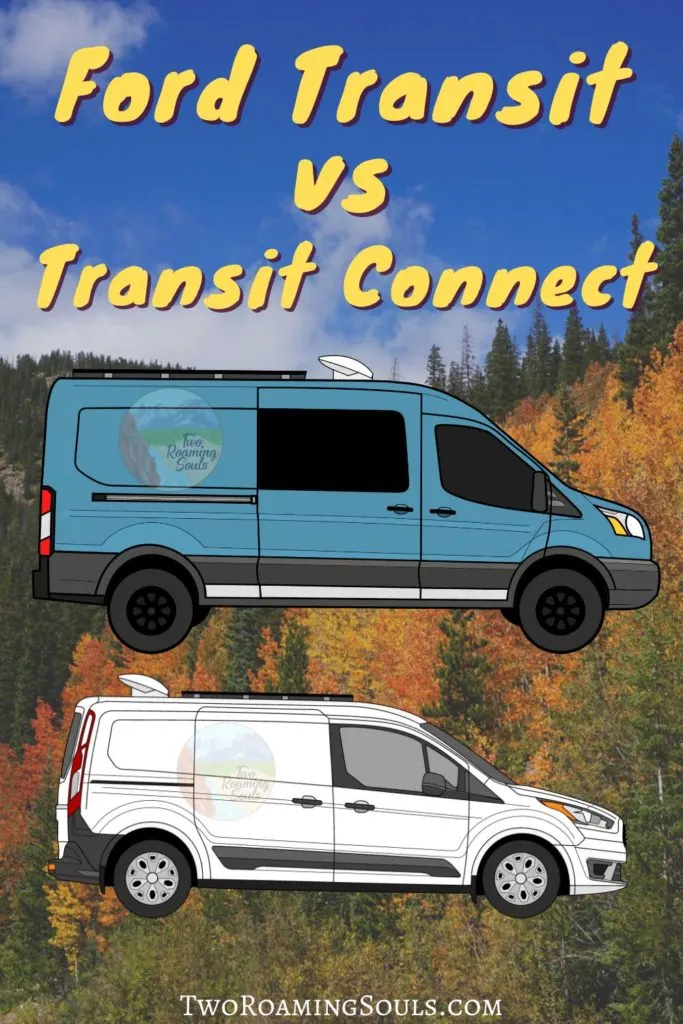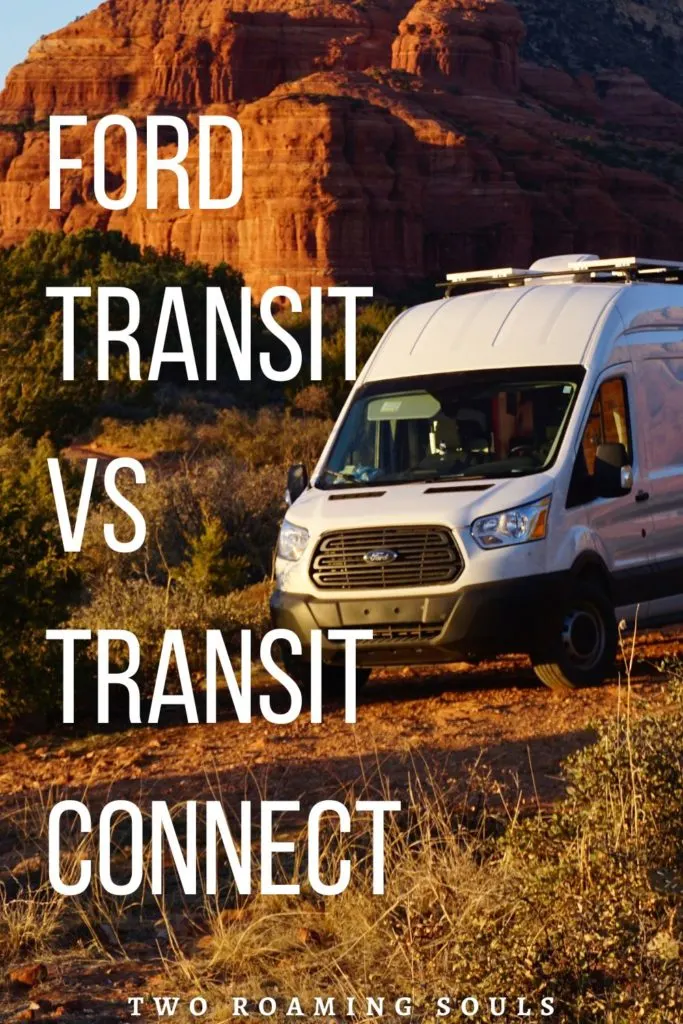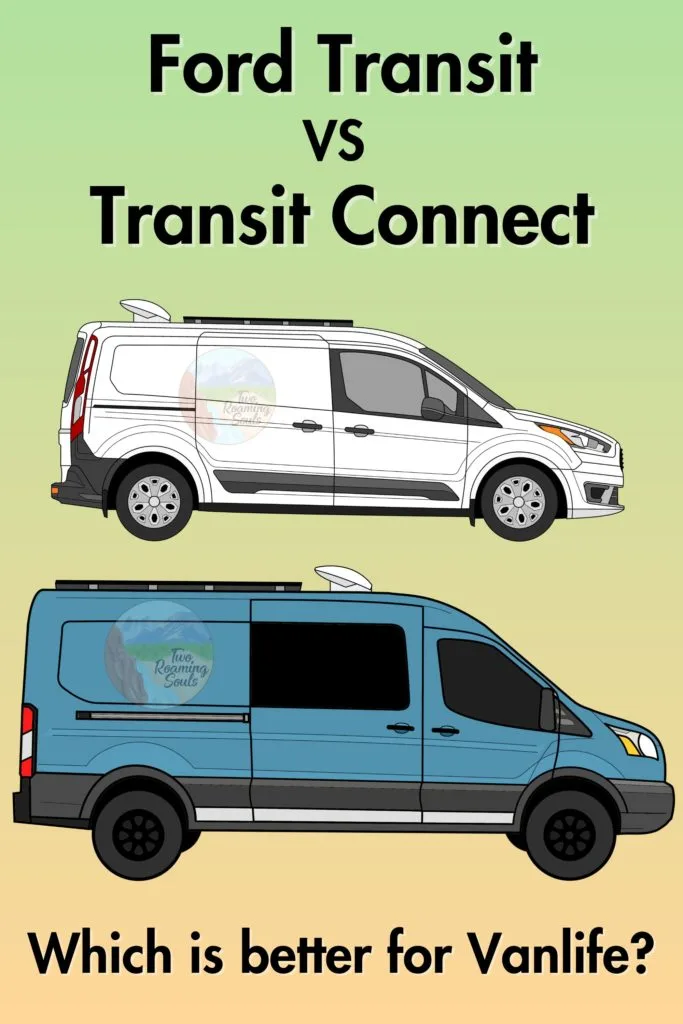
The Ford Transit and Ford Transit Connect are both very popular van choices for vanlife. But what exactly is the difference between Ford Transit and Ford Transit Connect? This post will explain the most critical vanlife considerations for Ford Transit vs Transit Connect.
By highlighting the key differences between these two vans, you can decide which one is better for you.
The Difference Between Ford Transit and Ford Transit Connect
Ford Transit is Ford’s full-size van offering, and the Ford Transit Connect is a car-based panel van.
Full-Size Ford Transit Van
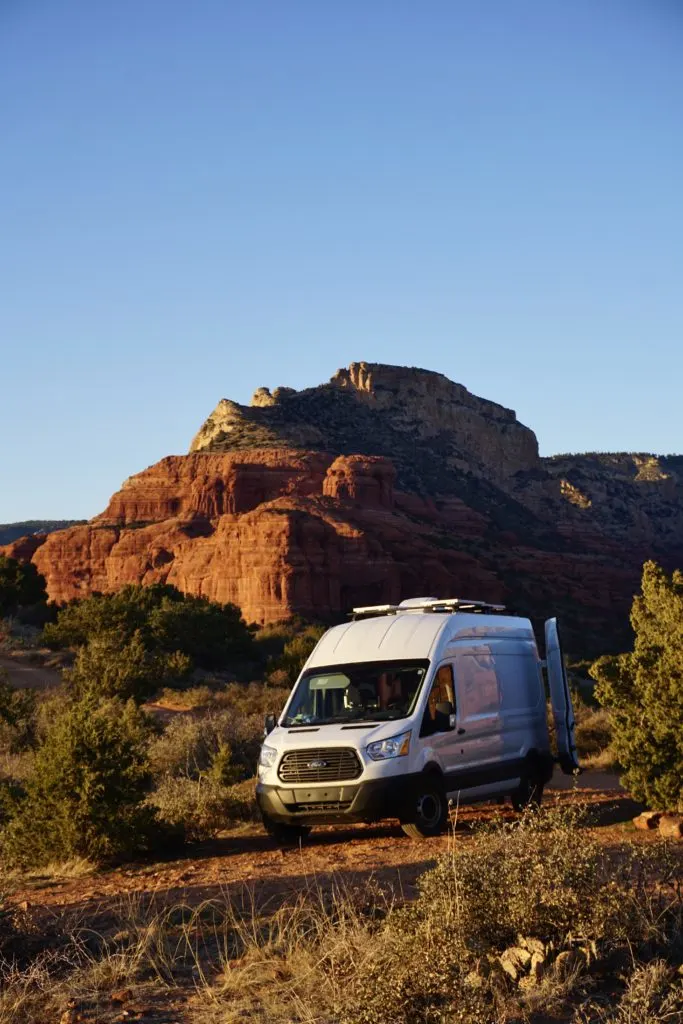
The Ford Transit is a full-size van lineup designed for medium to heavy-duty work. The Ford Transit replaced its former E-series van (Econoline).
The boxy unibody design of the Ford Transit has ushered Ford vans into the modern era. Its main competitors are the Mercedes Benz Sprinter, RAM Promaster, and Nissan NV.
Ford Transit Connect Van
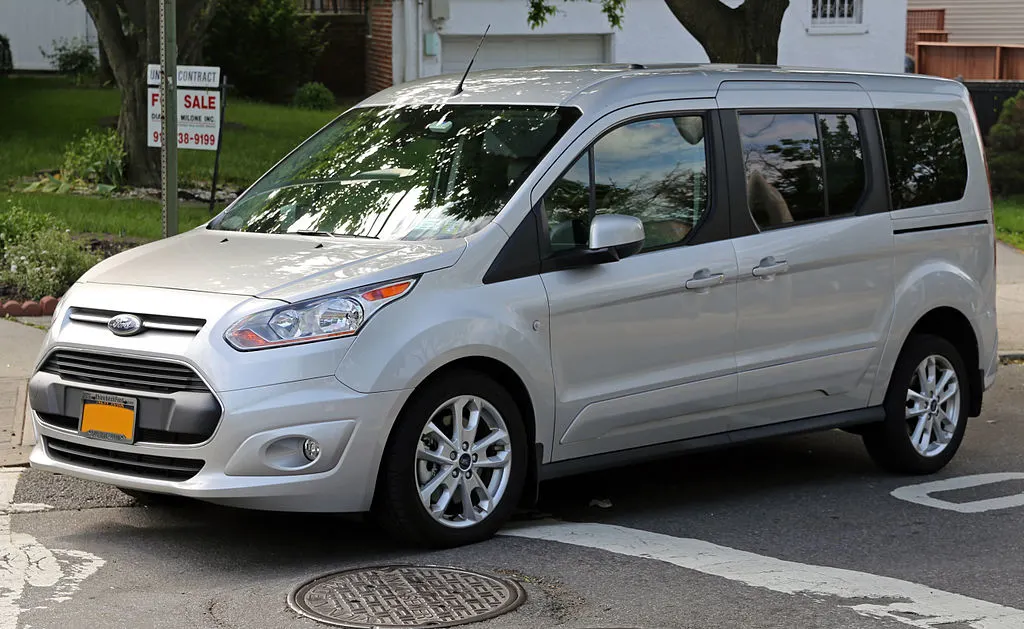
The Ford Transit Connect is a smaller light-duty van. Its smaller size makes it better suited to urban driving. Its main competitors are other city vans like the RAM Promaster City, Nissan NV200, Chevy City Express, and Mercedes Metris.
But it’s worth mentioning that the Ford Transit Connect was discontinued in 2023 (actually the entire “city vans” segment has been discontinued).
So if you want to purchase a new Ford van, then a full-size Ford Transit is your only option.
Pros and Cons of Ford Transit Van
Pros: Ford Transit
- Higher payload rating
- Lots more cargo space
- Higher ground clearance
- Tall enough to stand (mid-high roof models)
- More size options
- Better for off-roading
- More roof space
Cons: Ford Transit
- Worse fuel economy
- Harder to drive
- More expensive to buy
- Only shortest length fits in a normal parking space
- Only lowest roof fits in a parking garage/drive thru
- More expensive parts & maintenance
Pros and Cons of Ford Transit Connect
Pros: Transit Connect
- Better fuel economy
- Easier to drive
- Less expensive to buy
- Fits in a normal parking space
- Fits in a parking garage/drive thru
- Less expensive parts & maintenance
Cons: Transit Connect
- Lower payload rating
- Lower towing rating
- Less cargo space
- Not tall enough to stand in
- Fewer size options
- Worse for off-roading
- Lower ground clearance
- Less roof space
Comparing the Specs of Ford Transit and Transit Connect
When you compare the most important metrics in the context of campervans, how do these two vans compare?
You will notice that the full-size Ford Transit has a much wider range of spec ratings. That’s because the full size Ford Transit Van has many more model configurations available (two wheelbases, three lengths, three roof heights, and two different engines).
The Ford Transit Connect only comes in long wheel base (LWB) and short wheel base (SWB).
Data for this post comes from Ford’s official 2021 spec sheets for both vans.
Engine & Powertrain
The full size Ford Transit van comes with a gas 3.5L V6 engine (standard or EcoBoost). Ford Transit Connect comes with either a 2.0L GDI I-4 Flex Fuel (regular unleaded or E85) or a 2.5L iVCT I-4 engine.
Put simply, the Ford Transit is a six-cylinder engine and the Transit Connect is a four-cylinder engine.
The Ford Transit is capable of producing a lot more total horsepower and torque. Though when considered in relation to vehicle weight, the difference may not be as profound as it seems.
Payload Ratings
The Ford Transit payload ratings range from 3,060 – 4,550 lbs depending on the model.
The Ford Transit Connect has a payload rating of 1550 lbs for long wheel base (LWB) and 1510 lbs for short wheel base (SWB).
Even the lowest payload Ford Transit has double that of the Ford Transit Connect.
This is obviously a big factor for how much weight you can add to your conversion. Things like batteries, water tanks, and wooden furniture are some of the heaviest parts of a van conversion.
Cargo Volume
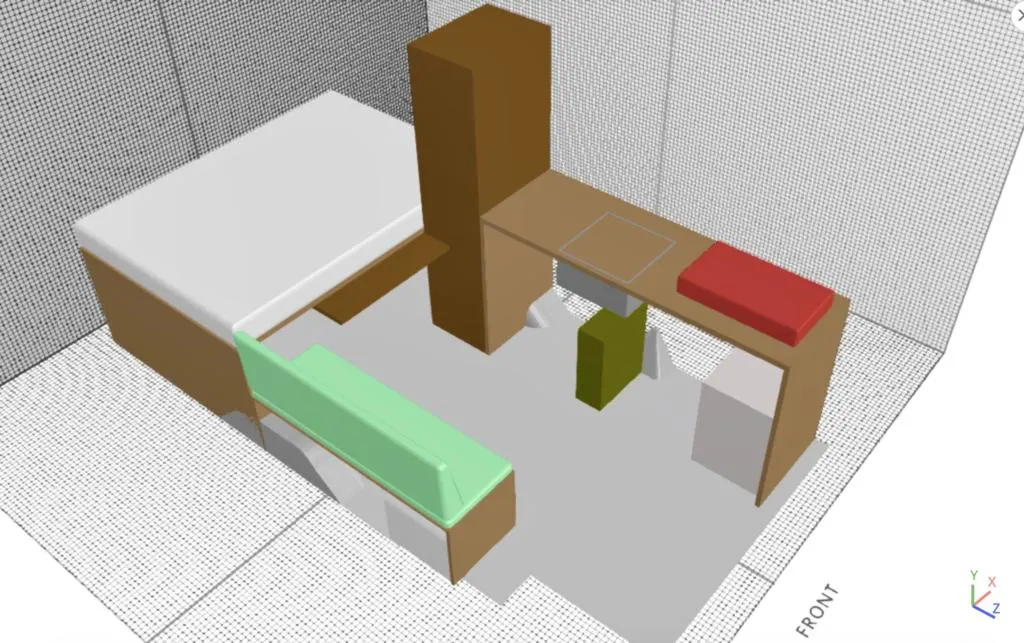
The cargo volume in a van is a measure of the physical interior space measured behind the front seats. Or simply, the area you have to build the living space of your van conversion.
The Ford Transit has an interior cargo volume ranging from 247 cubic feet to a whopping 404 cubic feet!
The Ford Transit Connect has an interior cargo volume of 127.4 cubic feet (LWB) or 104.8 cubic feet (SWB).
Payload To Cargo Volume Ratio
But neither payload nor cargo volume alone can really tell the whole story.
If we take the total payload and divide by cargo volume, it provides a more comprehensive metric: pounds per cubic foot.
This measure gives a clearer picture of how weight should factor into the weight of our van conversion materials.
What I found, was somewhat surprising…
| Van Type | Pounds / cubic ft | Specs |
| Ford Transit: Regular Length, Low Roof | 15.3 | Payload ≈ 3450, Volume ≈ 224.5 |
| Ford Transit: Long Length, High Roof | 10.7 | Payload ≈ 3900, Volume ≈ 365 |
| Ford Transit Connect: LWB | 12.2 | Payload ≈ 1550, Volume ≈ 127.4 |
The LWB Transit Connect actually beats out the long-length high-roof Transit in this metric (12.2 lbs/cu.ft. and 10.7 lbs/cu.ft, respectively).
So the fact that the Ford Transit Connect has less total payload is less consequential than it might seem.
Because the Transit Connect has less space overall, the payload issue is somewhat self-regulating. There’s only so much weight you could pack into a small space.
Towing Ratings
The Ford Transit Van has a towing rating of 3,590-4,550 lbs.
The Ford Transit Connect has a towing rating of 2,000 lbs.
Keep in mind that towing packages are not included with every Ford Transit. So a hitch may need to be added for towing.
Fuel Economy: Ford Transit & Transit Connect
Ford Transit Full-Size Van has a combined mpg rating of about 16.5 mpg.
The Ford Transit Connect has a combined mpg rating of 25 mpg.
The increased fuel efficiency is probably one of the biggest selling points of the Transit Connect.
Range
The full size Ford Transit comes standard with a 25 gallon fuel tank. It has an optional 31 gallon fuel tank.
The Ford Transit Connect has a fuel tank size of 15.8 gallons.
So I estimate the range of a Ford Transit to be 412.5 miles on a single gas tank. The Ford Transit Connect has an estimated range of around 395 miles. That’s only about 20 miles less with Transit Connect.
However, if you spring for the optional 31-gallon fuel tank on the Ford Transit, you can extend your range to about 511 miles, which is a significant difference.
Range is probably only a factor for van lifers who intend to travel to remote off-grid destinations.
Cargo Height
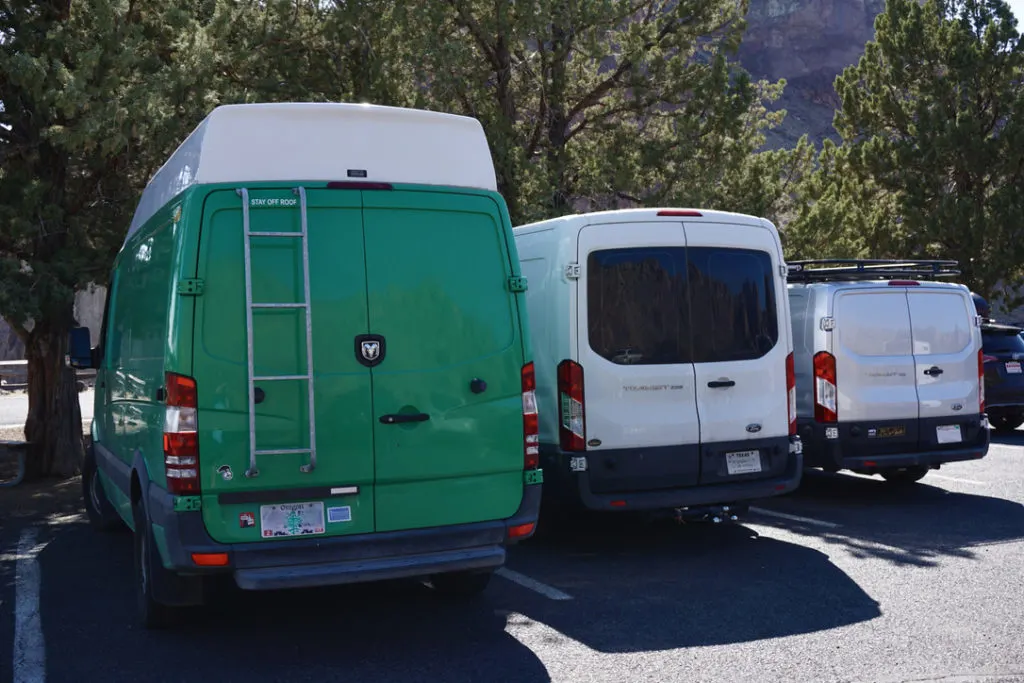
One of the biggest benefits of the full size Ford Transit is the ability to stand inside. But this is only true for the High Roof, and potentially Mid Roof Transits. (What are all the vans tall enough to stand up in?)
The High Roof Ford Transit has a maximum interior cargo height of 77 inches (6’5”).
The Mid Roof Ford Transit has a maximum interior height of 67.6 inches (5’7.6”). So shorter people may still be able to stand up in the mid roof Transit.
The Low Roof Ford Transit has a maximum interior height of 52.8 inches (4’4.8”). So basically nobody can stand in a low roof Transit.
The same is true for all versions of the Ford Transit Connect. The maximum interior height of a Transit Connect is 49.8” (4’1.8”).
Keep in mind that when planning a van conversion, you will typically lose about 3-6 inches of interior height due to conversion materials. Your insulation, flooring, and ceiling will all subtract from the total interior height of your van.
Vehicle Height
But there is a downside to taller vehicles. Taller vehicles are often unable to fit in parking garages and drive-thrus. Another negative is that taller vehicles are harder to control in the wind and get “pushed” around more by semi trucks passing by.
The Ford Transit high roof will not be able to fit in most parking garages and drive-thrus. The Mid Roof Transit can sometimes fit in parking garages and drive-thrus, depending on roof-mounted additions.
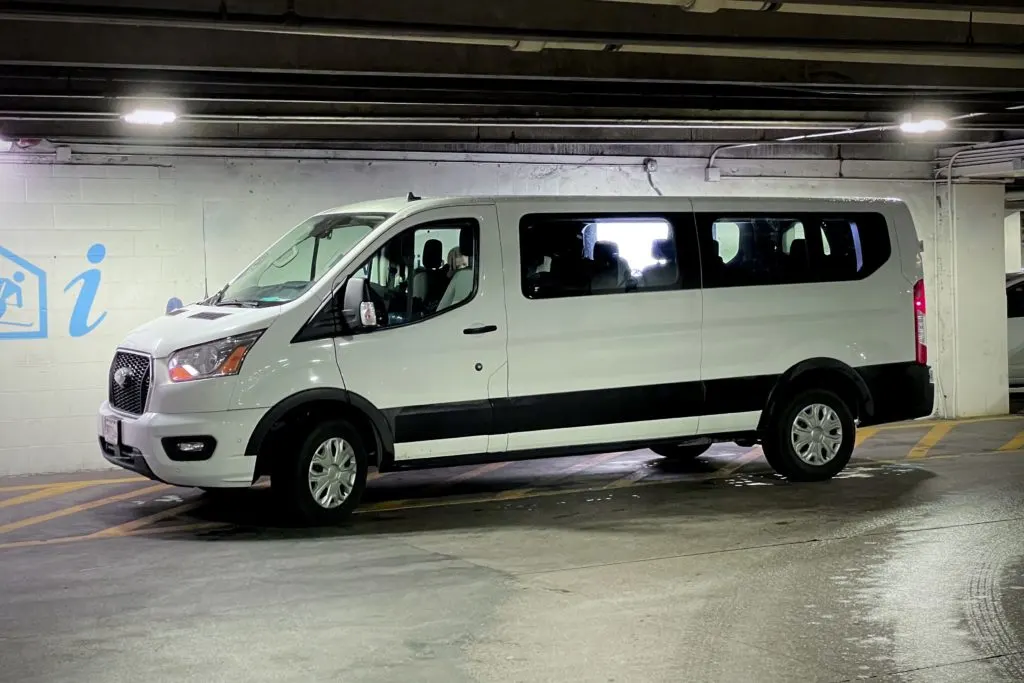
However, all Ford Transit Connects and Low Roof Transits can fit pretty much anywhere, as long as you don’t mount really tall things on the roof.
The average drive-thru in US is 9 feet (108”).
| Vehicle Type | Exterior Height |
| Ford Transit Connect | 72″ |
| Ford Transit: Low Roof | 82.5″ |
| Ford Transit: Mid Roof | 100″ |
| Ford Transit: High Roof | 110″ |
Interior Cargo Width
The interior width of a van is most relevant when considering putting your bed sideways across your van.
The Ford Transit Connect is much too narrow for sleeping oriented from wall to wall.
Only the Ford Transit is possibly wide enough to sleep from window to window.
But this depends entirely on your height and bed placement.
The Ford Transit is about 70” wide at its widest interior point. But you probably need to be at least a few inches shorter than that to fit your insulation, walls, blankets, etc. My other post explains much more about the specifics of trying to sleep width-wise in your campervan conversion.
Drivetrain
The Ford Transit is available in all-wheel-drive (AWD) and rear-wheel-drive (RWD). The Ford Transit Connect is only available in front-wheel-drive (FWD).
The AWD Transit will perform the best (compared to other Transits) in low traction situations like: snow, dirt, sand, mud, and rain. But considering that an AWD model costs about $4,000 dollars more, you might reconsider whether you really need an AWD camper van.
A Transit Connect has one advantage in the snow since front-wheel-drive tends to understeer when traction is lost. Whereas a RWD Ford Transit is less safe in the snow because of rear-wheel-drive’s tendency to oversteer or “fishtail” when traction is lost.
However, there are lots of other factors that contribute to driving safety. The most important of which is a good set of tires for vanlife and careful driving.
Off-Roading: Ford Transit vs Transit Connect
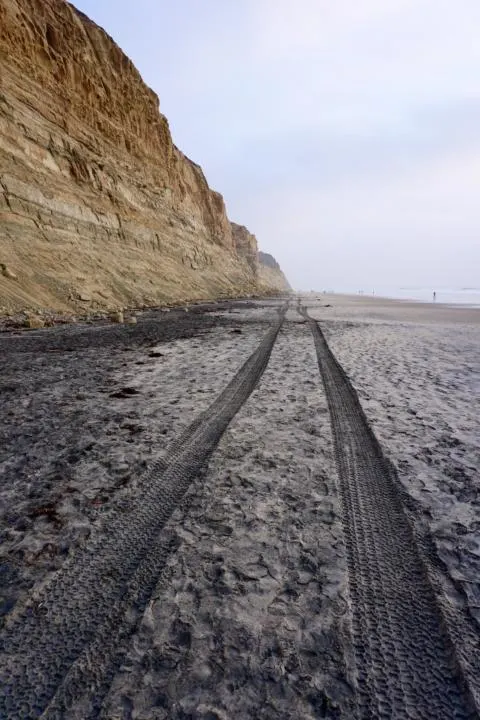
When it comes to off-roading, the Ford Transit is better equipped to handle it.
Rear-wheel drive is better than front-wheel drive when climbing steep dirt roads because weight is shifted to the rear axle. But the AWD Transit will maintain the best traction across all situations.
And lastly, the Ford Transit has higher ground clearance and larger tires that are better for off-road driving. The ground clearance of the Ford Transit is about 6.5 inches, compared to about 5.5 inches on the Connect.
One inch doesn’t seem like much, but serious off-roaders will spend thousands of dollars just to eke out an extra inch or two of ground clearance.
If you have big ambitions for off-roading, check out my review of the Ford Transit Trail. A specially-designed adventure and vanlife-ready version of the Ford Transit.
Vehicle Construction
The reason these two seemingly similar vans can have vastly different specs is due to their design and construction.
While they are both unibody designs, the Ford Transit still has a large ladder frame underneath the length of the van, similar to the body-on-frame design used in trucks. This truck-like design is better for hauling heavy loads and resisting frame warping offroad.
While the Transit Connect uses a car-based unibody design to greatly reduce weight and unlock that incredible fuel efficiency. But obviously comes at the sacrifice of power and interior space.
Driver Experience

The full-size Ford Transit van will probably take some getting used to for most people, especially the extra-long models. So there can be an adjustment period for learning how to drive a bigger vehicle (i.e. wider turning radius, longer stopping distance, less responsive handling, harder to park.)
However, the Ford Transit Connect drives basically like a sedan. Nearly anyone will quickly feel comfortable driving them.
If you intend to spend lots of time in urban or densely populated suburban areas, then Transit Connect is the obvious choice.
Price Comparison Of Ford Transit vs Transit Connect
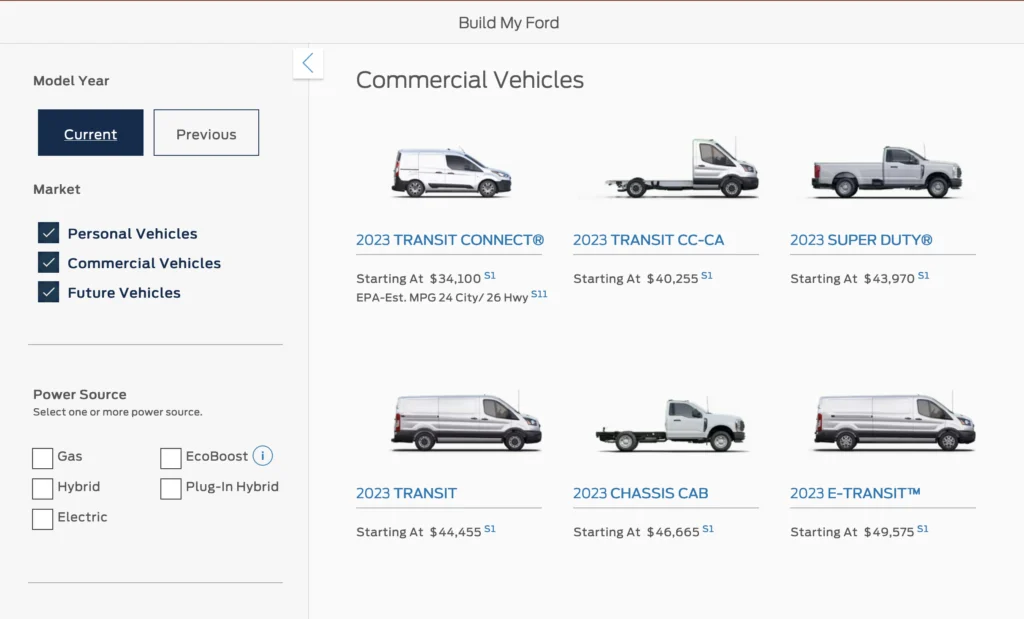
The Ford Transit van starting MSRP is $44,445.
The Ford Transit Connect van starting MSRP is $35,000. (I excluded short wheelbase)
So you are spending about 10,000 dollars or more to get a base model full size Ford Transit vs Transit Connect. But a long length high roof Ford Transit loaded with extras can easily exceed $60,000.
All-Electric Ford Transit Van
The Ford E-Transit is the only all-electric Ford van available. However, in my opinion, electric vans are not yet suitable for vanlife. Though there is certainly a promising future there.
Takeaway: Ford Transit vs Ford Transit Connect
So, when choosing between a Ford Transit vs Transit Connect, there are a few obvious factors to consider.
The biggest reasons to choose a full-size Ford Transit for your campervan are…
- Much more interior space
- Tall enough to stand*
- Better for full-time vanlife comfort
- Better for couples
- Bigger roof for solar and gear
- Better for off-roading
- Available All Wheel Drive (AWD)
- Can be bought new
The biggest reasons to choose a Ford Transit Connect for your campervan are…
- Better fuel economy
- Lower purchase price
- Cheaper parts and maintenance
- Easier to drive and park
- Better as a daily driver
- Better for urban areas
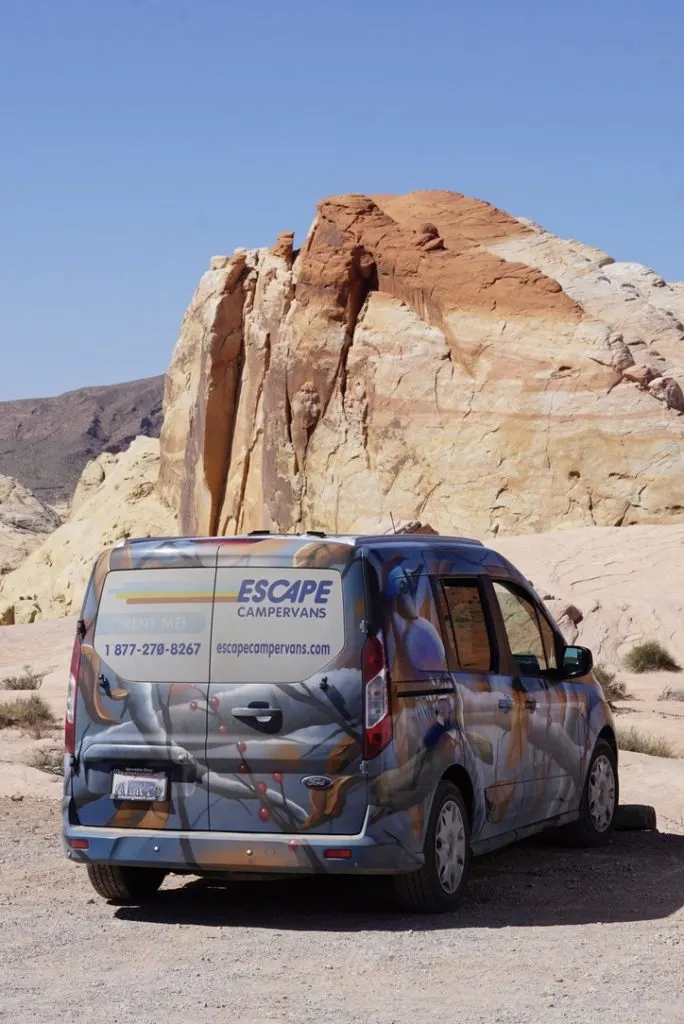
If you are still not sure, you could try renting a campervan, to give vanlife a spin in one of these vans. There are numerous campervan rental companies that offer Ford Transits and Transit Connects.
Not sold on a Ford van? Check out my other post about choosing the perfect van for a van conversion.
Share ‘Ford Transit vs Transit Connect’ On Pinterest!
